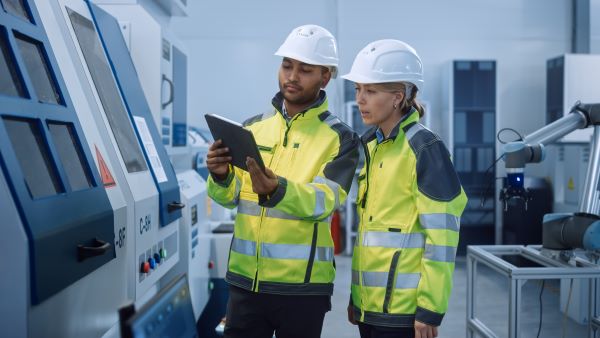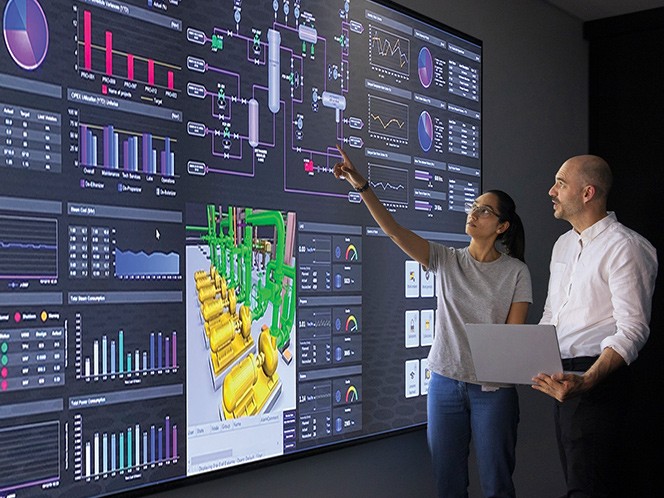Connecting the future: How industrial data communities will create a sustainable world
Written by Peter Herweck, Chief Executive Officer, AVEVA
Imagine a completely connected world, where industrial teams are able to collaborate using integrated data from diverse sources—not only with colleagues, but also with suppliers, partners and even customers. In this world, you can connect people in real time, transforming complex value chains into agile, sustainable growth networks. This is the connected industrial economy, founded on trusted information and insights, and it’s already begun. As we kick off 2023, let’s take a moment to explore what this connected future can offer businesses.
Faced with a world in turmoil, it can be a struggle to optimize performance. In fast-changing times, companies that acquire the right data sets and apply the right analytics to derive key insights and build desirable capabilities can achieve desired business outcomes 2.5X faster than those that operate in data silos.1 This is because using rich insights boosts collaboration and empowers teams with the resilience and agility that they need to seize the moment.

At AVEVA, we see this phenomenon of pooling data in context and strategically sharing it with partners, suppliers and even customers is fundamental to enabling the connected industrial economy. As value chain partners begin to harmonize, they yield unprecedented economies, synergies and benefits that accrue to the partners and society at large. We believe this opportunity promises to transform how industries operate in 2023 and beyond.
Accessing the connected industrial economy can drive 5% growth
Sharing data beyond your own four walls is increasingly fundamental to enterprise success. Jeffrey Hojlo of IDC states, “By the end of 2023, organizations that share data, applications, or operations with their ecosystem partners through joint ventures will increase profitability by five percentage points.” There is immense opportunity for industries to harness the power of connected data to unlock deeper insight by enabling colleagues, partners event customers to work more closely.2
Building a digital twin founded on rich, high-quality data enables teams to revolutionize how they can engineer and operate energy assets. Some companies are going further and starting to integrate data from diverse sources across an organization or value chain and visualizing in a structured way, you spark human ingenuity. This new way of working is not only effective, but also more fun: When people work together on problems, they gain access to expertise in different disciplines and enjoy imaginative conversations that spark new ideas to solve challenges through a continuous flow of information and insight.
Because this innovation is happening in the cloud, teams can log on from any device, anywhere, at any time, to check in on business data and automated systems. They can interact with colleagues in other parts of the world in real time. When you plug in the power of artificial intelligence (AI), you can also harness predictive and prescriptive methodologies to trial new concepts and forecast potential outcomes. An individual can do all this on their own—and yet, it’s a richer experience when everyone else in the team is collaborating, too. It also drives higher value.
We are already seeing this digital collaborative approach succeed in the accelerated timescales within which companies from Pfizer to AstraZeneca delivered the vaccine against Covid-19. We are seeing it in the ways in which energy leaders like Shell are using their digital twin infrastructure to drive decarbonization. Indeed, many companies are using software models to test and define the most efficient operating envelope for everything from chemicals refineries to chocolate factories.
If the metaverse is happening already, what will be new in 2023?
With the models stress-tested by the pandemic becoming today’s new benchmarks, we expect to see a rapid proliferation of digital twin-based innovation in the coming year, supported by further immersive experiences. But in the IDC blog post, Hojlo strikes a word of warning: The power of visualizing data in an immersive way—the metaverse—is transforming how industries can model and predict challenges and adjust their strategies intuitively.
But it’s not as simple as just bringing data together. That data needs to be supported by sector-specific understanding and the knowledge and organizational experience to drive structured and meaningful action. Hojlo adds in the IDC blog post, “By 2023, only 20% of metaverse experiments for industry ecosystems will succeed, as organizations continue to evolve their ability to deliver products and services in a blended physical and digital way.” This is Pareto’s principle: Not all innovations will be successful, but we can expect the ones that do succeed to achieve exponential growth.
The connected industrial economy is coming. Are you ready?
At AVEVA, we have been working on and in the industrial metaverse for 12 years. We have learned that it takes a combination of rich, contextual data coupled with industry expertise to visualize actionable results. We are working on groundbreaking deployments with customers in the world over that will transform the depth of insights that operational teams can draw upon to optimize value chains and drive revenue.
We are also supporting many customers as they seek to unify and share data. We call this the connected industrial economy and we believe it’s set to transform how industries can operate and grow. To prepare for this, we are already seeing businesses begin to remove data silos first, then select areas where both the internal organization and the partner organizations are receptive to change, driving deeper benefits to all parties through closer connections. We look forward to these bearing fruit in 2023.
In times of rapid change, it’s hazardous to predict the future. Yet, if I look at the trends of our own and our customers’ businesses, I am confident that the drive to collaborative, data-driven innovation will accelerate in 2023. We are seeing the increasing blurring of lines between actors across diverse industrial value chains as companies realize that through sharing data and breaking down silos, they can increase the value for everyone. This connected approach also increases the sustainability and decarbonization benefits too.

There’s much talk of the birth of the metaverse. Just as exciting is the dawn of what we at AVEVA call this connected industrial economy. As digital twins merge and new operating models develop, we anticipate that this trend will accelerate data-driven extended ecosystem collaboration. It’s an exciting prospect, and a privilege to have a ringside seat. As we look at our own business, we are also exploring opportunities to drive deeper sustainability through increased data collaboration and information sharing in our own value chain as well.
What’s truly exciting is that such models are ushering in unprecedented synergies not only for individual enterprises and their value chain partners, but also in beginning to solve humanity’s greatest challenges. Such extraordinary data-driven collaboration can deliver game-changing vaccines for a once-in-a-generation pandemic, accelerate decarbonization in the race to net zero, and reduce waste in a hungry world.
It’s clear 2023 will bring further challenges for global organizations. As we face the new year, I’m inspired to see how technology will enable us to thrive together.
1IDC FutureScape: Worldwide Future of Digital Innovation 2023 Predictions blog, November 2022
2IDC Blog, IDC FutureScape: Worldwide Future of Industry Ecosystems 2023 Predictions, December 2022